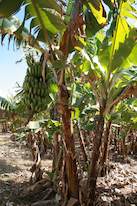Propagation

Propagation in the wild is from seed. But commercial farming is by planting rhizomes or removing suckers from adult plants and planting these out.
This is normally done in a nursery and the established plants are planted out into orchards. The multiplication of plants by tissue culture is practiced as well.
Planting Method for Bananas
When planting bananas, the plant area is prepared by removing debris and adding preplant fertilizer, manure and compost along the plant rows and then ripping the area and levelling the field. Irrigation is installed if the rainfall of the area is not enough. If the plants are in bags and are about 30 cm tall, and have been sufficiently rooted, then the plants are planted into a 30x30x30cm hole and closed and soil is slightly compacted.
If tissue culture plants or cuttings (bits) with buds are planted, then the same procedure is followed - only the plant holes are smaller and the bud on the bits should preferably not be deeper than 10cm under the soil. If suckers are cut from existing plants, they should be planted in the same way into holes 20 to 25cm deep. The plants should be well watered after planting so they can settle in.
Spacing
Plants should be spaced 2 meters apart in rows that are 3 meters apart. This is about 1600 plants per hectare. Plantings of 3 meters by 1.5 meters are also common giving about 2220 plants per hectare.
Planting Time
Planting of bananas in South Africa is normally in November and December as this is the rain season in the summer rainfall areas. Temperatures are also warmer for better establishment and growth.
Growth Period
It will be about 10 to 12 months before the first bananas appear.
Fertilisation
It is imperative to provide the correct nutrients to produce a reasonable crop. Nitrogen is very important for sustained vegetative growth and Potassium is extremely important for fruit development.
The banana plant is a very heavy Potassium consumer. As phosphates are more difficult to make readily available to the plants, it is advisable to work this requirement into the soil prior to planting.
Irrigation
Bananas are generally planted in areas that enjoy 2400 mm and more of rain, evenly distributed throughout the year. Where other suitable climatic conditions are present, and rainfall falls short, then irrigation is imperative. Bananas are very sensitive to moisture stress so irrigation regimes must be very strict.